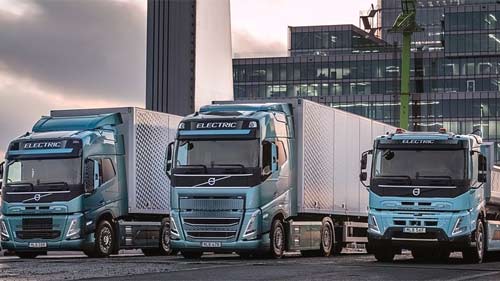
While much attention is given to sustainable solutions for personal transport, commercial transport – including auto transport, supply chain logistics, and trucking – plays an equally significant role. As such, it’s crucial to explore and implement sustainable practices in this industry. Here are the key sustainable commercial transportation solutions that are reshaping the future of freight:
1. Electric Trucks
Electric trucks offer an exciting opportunity to reduce the carbon footprint of the freight industry. Several manufacturers, including Tesla and Volvo, are already developing electric trucks, ranging from light-duty delivery trucks to heavy-duty 18-wheelers. These vehicles produce zero tailpipe emissions and can be powered by renewable energy sources, making them a promising solution for sustainable freight transport.
2. Biofuels
Biofuels are derived from renewable resources like plants and waste materials, making them a more sustainable option than fossil fuels. Biodiesel and ethanol, two common types of biofuel, can be used in existing diesel engines with little to no modification. This makes biofuels an attractive option for greening existing fleets without a significant upfront investment.
3. Hydrogen Fuel Cell Trucks
Hydrogen fuel cell technology offers another potential solution for sustainable commercial transport. Hydrogen fuel cell trucks generate electricity from hydrogen, emitting only water vapor as a byproduct. They offer similar ranges and refueling times as diesel trucks, making them a practical alternative for long-haul freight transport.
4. Rail Freight
Trains are one of the most energy-efficient modes of transport, capable of moving large quantities of goods over long distances with far less fuel than trucks. Shifting more freight from road to rail could significantly reduce the carbon footprint of the transport sector. Some rail companies are also exploring hybrid and hydrogen-powered trains to further improve sustainability.
5. Efficient Routing and Load Optimization
Modern GPS tracking and routing software can help logistics companies plan the most efficient routes, reducing unnecessary mileage and fuel consumption. Similarly, load optimization software can ensure trucks are filled to capacity, reducing the number of trips needed to transport the same amount of goods.
6. Energy-Efficient Warehouses
Sustainability in commercial transport isn’t just about the vehicles; it’s also about the infrastructure supporting them. Energy-efficient warehouses, equipped with features like LED lighting, solar panels, and smart thermostats, can significantly reduce the energy footprint of the logistics sector.
7. Slow Steaming for Ocean Freight
Slow steaming – the practice of operating cargo ships at slower speeds – can significantly reduce fuel consumption and emissions in the maritime shipping industry. While it does increase transport times, careful planning and scheduling can mitigate the impact on delivery timelines.
Other Emerging Technologies in Commercial Transportation
As we continue to innovate and adapt, emerging technologies are playing an increasingly crucial role in creating sustainable commercial transport solutions. These advancements are not only making freight and logistics more eco-friendly but also more efficient and cost-effective.
Artificial Intelligence (AI) in Auto Transport
One of the most exciting developments is the application of artificial intelligence (AI) in auto transport. AI can be used to optimize routes and reduce fuel consumption, based on real-time traffic data, weather conditions, and other factors. This not only improves sustainability but also reduces delivery times and costs to ship a car.
Self-driving trucks have the potential to significantly reduce emissions by driving at optimal speeds and minimizing unnecessary braking and accelerating. Companies such as Waymo and Tesla are already testing autonomous trucks, indicating a not-too-distant future where freight transport may be largely automated.
Internet of Things (IoT) and Telematics
The Internet of Things (IoT) and telematics technologies allow for real-time tracking and monitoring of vehicles and cargo. This enables logistics companies to optimize their operations and quickly respond to any issues, improving efficiency and reducing waste. Sensors can monitor vehicle performance and alert operators to any maintenance needs, preventing breakdowns and reducing downtime.
Blockchain in Supply Chain
Blockchain technology, while commonly associated with cryptocurrencies, has significant potential in supply chain management. It can provide a secure, transparent record of product movements, helping to prevent fraud and improve traceability. This can enhance efficiency and accountability in the logistics sector.
Electric Vertical Takeoff and Landing (eVTOL) Vehicles
Electric vertical takeoff and landing (eVTOL) vehicles are an emerging technology with potential applications in freight transport. These aircraft can take off and land vertically like a helicopter but fly like a plane, making them suitable for urban deliveries where space is limited. As these vehicles are electric, they offer a sustainable alternative to traditional air freight.
The commercial transportation industry is on the cusp of a technological revolution. Emerging technologies like AI, IoT, blockchain, and eVTOL are not just making freight transport greener, but also smarter and more efficient. By embracing these innovations, the industry can move towards a sustainable future while also improving service and reducing costs. The road ahead is exciting and full of potential, promising a new era of sustainable, high-tech commercial transport.
The Future is Here
Sustainable commercial transportation solutions hold the key to reducing the carbon footprint of the freight and logistics sector. From electric and hydrogen-powered trucks to biofuels, rail freight, efficient routing, and energy-efficient infrastructure, there is a multitude of ways to make commercial transport more environmentally friendly.
However, the successful implementation of these solutions requires commitment and cooperation from all stakeholders in the industry, including manufacturers, logistics companies, and policy-makers. Public policies that incentivize sustainable practices and investments can accelerate the transition to greener commercial transport. At the same time, customers and businesses can drive demand for sustainable logistics by prioritizing suppliers that commit to green practices.
Moreover, investing in sustainable commercial transport can offer significant business benefits in addition to environmental ones. Fuel-efficient vehicles and operations can lead to substantial cost savings in the long run. Companies that embrace sustainability can also enhance their brand image and appeal to environmentally conscious consumers and investors.
The journey towards sustainable commercial transport is a challenging one, but the potential rewards – for businesses, consumers, and the planet – are immense. As we move forward, it’s essential to keep exploring and innovating, turning the challenges of today into the sustainable solutions of tomorrow. The future of freight is green, and it’s up to us to make it happen.




